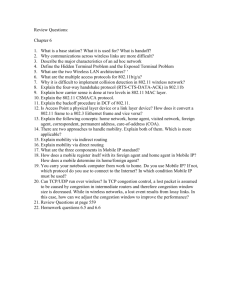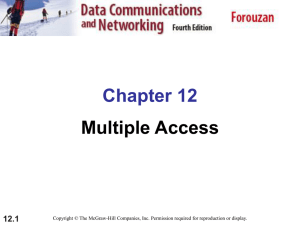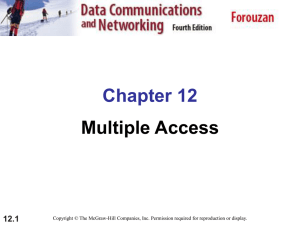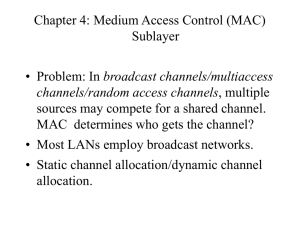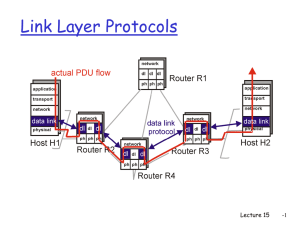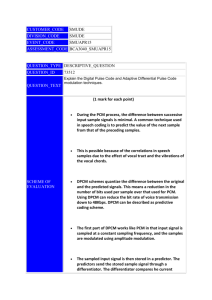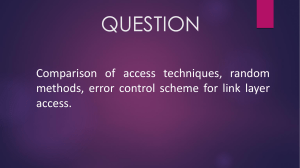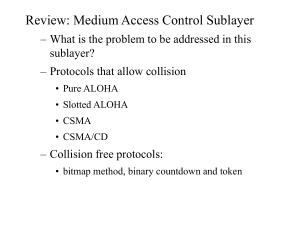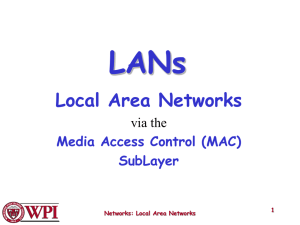MAC Sublayer - Winona State University
advertisement
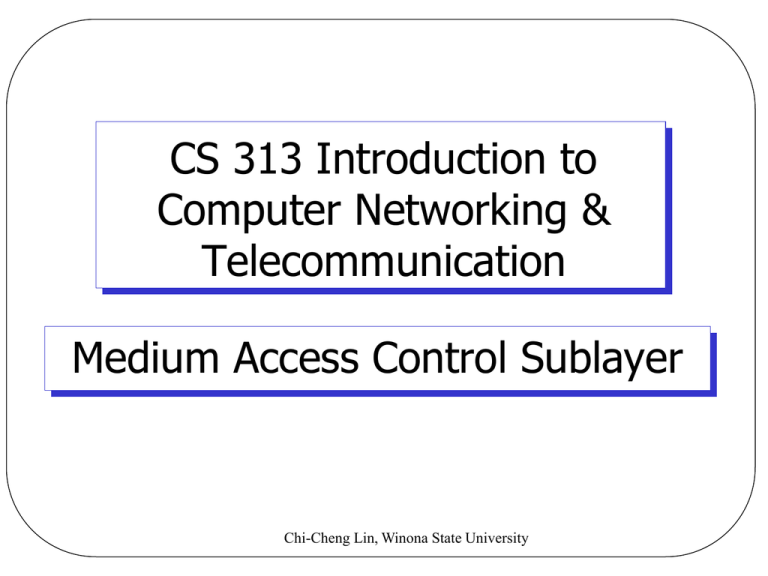
CS 313 Introduction to Computer Networking & Telecommunication Medium Access Control Sublayer Chi-Cheng Lin, Winona State University Topics Introduction Channel Allocation Problem Multiple Access Protocols CDMA 2 Introduction Broadcast networks Key issue: who gets to use the channel when there is competition Referred to as Multiaccess channels Random access channels MAC (Medium Access Control) sublayer LANs Wireless networks Satellite networks 3 Channel Allocation Problem Channel Allocation Static Dynamic Performance factors Medium access delay Time between a frame is ready and the frame can be transmitted Throughput #frames can be transmitted in unit time interval 4 FDM Static Channel Allocation Bandwidth divided into N equal sized portions for N users Problems #senders large #senders continuously varies bursty traffic Discussion: #users > N ? <N? =N? N times worse than all frames queued in one big queue 5 Static Channel Allocation TDM Each user is statically allocated every Nth time slot Same problems as FDM Under what circumstances are static channel allocation schemes efficient? 6 Dynamic Channel Allocation Key assumptions 1. Station model Independent Work is generated constantly One program per station Station is blocked once a frame has been generated until the frame has been successfully transmitted 2. Single channel assumption 7 Dynamic Channel Allocation Key assumptions 3. Collision Assumption Collision: Two frames are transmitted simultaneously, overlapped in time and resulting signal garbled Can be detected by all stations No other errors 8 Dynamic Channel Allocation Key assumptions 4. Time: either continuous or discrete (slotted) Continuous Frame transmission can begin at any instant No "master clock" needed Slotted Time divided into discrete intervals (slots) Frame transmissions begin at the start of a slot #frames contained in a slot: 0 ? 1? >1 ? 9 Dynamic Channel Allocation Carrier sense ("carrier" refers to electrical signal): either Y or N Yes A station can check channel before transmission If busy, station idle Wired LANs No “Just do it" Can tell if transmission successful later Wireless networks, cable modems 10 Multiple Access Protocols ALOHA Carrier sense multiple access protocols (CSMA) CSMA w/ collision detection (CSMA/CD) Collision-free protocols Limited-contention protocols 11 ALOHA Applicable to any contention system System in which uncoordinated users are competing for the use of a single shared channel Two versions Pure ALOHA Slotted ALOHA 12 Pure ALOHA Let users transmit whenever they have data to be sent Colliding frames are destroyed Sender can always find out destroyed or not Feedback (property of broadcasting) or ACK LANs: immediately Satellites: propagation delay (e.g., 270msec) By listening to the channel If frame is destroyed wait a random amount of time and retransmit (why "random"?) 13 Pure ALOHA Where are the collisions? 14 Slotted ALOHA Discrete time Agreed slot boundaries Synchronization needed Performance Which ALOHA has a shorter medium access delay? Which ALOHA has a higher throughput? 15 Performance of ALOHA Slotted ALOHA can double the throughput of pure ALOHA Throughput versus offered traffic for ALOHA systems. 16 Carrier Sense Multiple Access (CSMA) Protocols Stations can listen to the channel (i.e., sense a carrier in the channel) Types 1-persistent CSMA Nonpersistent CSMA p-persistent CSMA 17 Performance of MAC Protocols Comparison of the channel utilization versus load for various random access protocols. 18 CSMA w/ Collision Detection (CSMA/CD) Can listen to the channel and detect collision Stop transmitting as soon as collision detected Widely used on LANs (e.g., Ethernet) Collision detection Analog process Special encoding is used 19 CSMA w/ Collision Detection (CSMA/CD) Conceptual model 3 states Contention Transmission Idle Minimum time to detect collision determines time slot Depends on propagation delay of medium 20 CSMA/CD Model 21 CSMA/CD Algorithm Source: http://www.10gea.org/gigabit-ethernet/ 22 Collision-Free Protocols Model N Stations: 0,1, ..., (N-1) Question Which station gets the channel after a successful transmission? Protocols Bit-map (i.e., reservation) protocol Token passing protocol Example: Token ring 23 Collision-Free Protocol Token Station Direction of transmission Token ring Performance of Contention and Collision-Free Protocols Contention Low load => low medium access delay :) High load => low channel efficiency :( Collision-Free Low load => high medium access delay :( High load => high channel efficiency :) 25 Summary of Channel Allocation Methods/Systems * * * * * * * * 26 * | Token Passing | Contention-free protocol |

